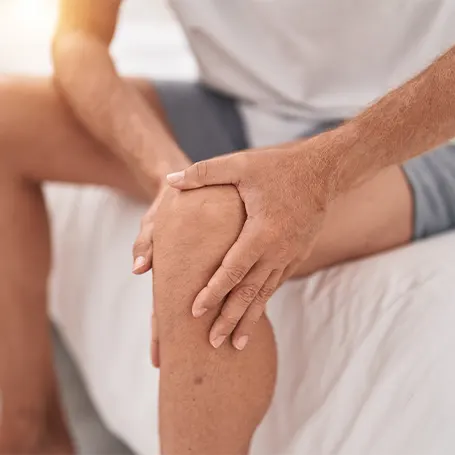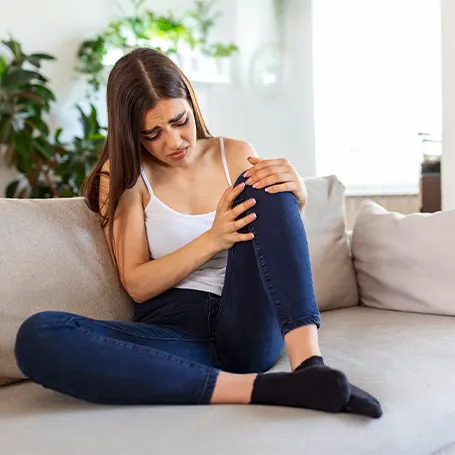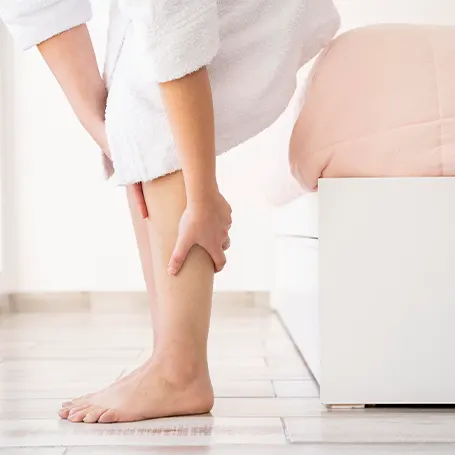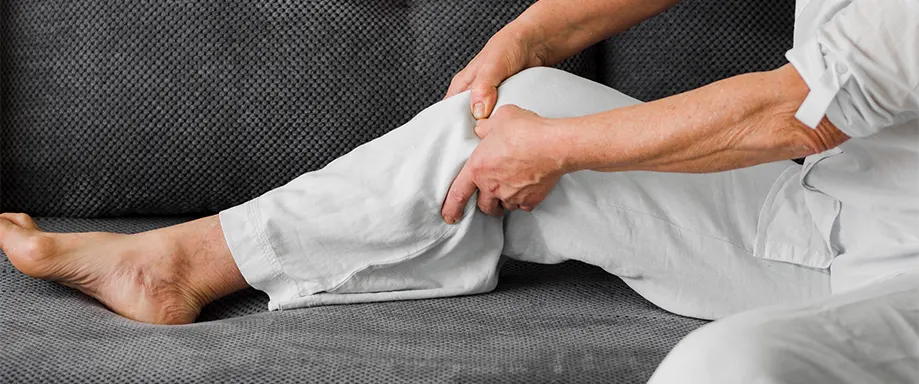What is causing throbbing leg pain when lying down?
As we've said in the intro, we'll first be going over a few conditions that can result in leg pain. Of course, this isn't an all-encompassing list and there are bound to be quite a few other conditions that can cause pain in one or both legs. So, we're just going to focus on the main conditions that typically get brought up when talking about leg pain when lying down.
A pulled muscle
The best-case scenario for a lot of people experiencing leg pain at night is that it's a pulled muscle. And determining whether this is the case should be rather simple. If you've been in the gym recently and did more strenuous exercises such as weighted squats, there's a good chance you pulled something.
However, you can also pull a muscle outside of the gym. For example, running or even walking for a prolonged period of time. Here we'd also like to mention the possibility of shin splints. This refers to pain in tenderness alongside your shin bone. If you're an athlete and have recently changed or intensified your training routine, this could be the cause as well.
Sciatica pain
As we've discussed when talking about sleeping with sciatica, this is a condition that can be caused by many different things. Generally speaking, it refers to issues with the sciatic nerve and usually manifests as mild to severe pain.
Sciatic pain is one of the more likely forms of nerve pain, as the sciatic nerve root is the largest in the body. However, as we'll discuss later on, you can somewhat relieve your aching legs by changing your sleeping position or getting a good mattress for sciatica.
Peripheral artery disease

Peripheral arterial disease (PAD) refers to a buildup of fatty deposits or plaque in the arteries that makes it more difficult for your blood flow to reach your legs. It can affect any blood vessels but it's typically most common in your legs. And we have to mention that this is a slightly more serious condition than in the previous segment.
This is because PAD typically subsides when you lie down. The aching pain is usually triggered and prolonged by physical activity, such as walking. So, if you're still experiencing leg pain when lying down, it could be a sign of critical limb ischemia. And, as the name implies, it's a more serious condition.
So, whether it's just poor circulation or a more serious form of PAD, it's best to consult a professional. Sometimes the condition can be treated with simple lifestyle changes but other times more specific treatments need to be used.
Venous insufficiency
Similarly to the previous segment, this condition is caused by insufficient blood flow. Only this time, the blood has problems getting back to your heart. This is caused by weakened vein walls and valves that don't succeed in pushing your blood all the way back to your heart.
The cause of venous insufficiency can be a number of things, from a blood clot to a history of deep vein thrombosis. In essence, anything that can stop your veins from carrying blood back to your heart can potentially fall under this category.
Varicose veins and spider veins
Since these two conditions have similar symptoms but are generally less dangerous, we wanted to mention them here as well. For a lot of people, varicose veins won't make you feel pain or anything like that. They're just visible veins that you might not like to look at.
However, varicose veins, and spider veins, can potentially cause pain and swelling in the legs as well as even blood clots in some cases. So, if you do have varicose veins, it could be wise to have a medical professional take a look, even if they're not causing any aches right now.
Is leg pain when lying down a warning sign of vascular disease?

Since the previous segment was sure to make quite a few of you uneasy, especially if you're a hypochondriac, let's talk about how likely this outcome is. First off, it's important to take into account how long you've been experiencing leg pain. If it has only been a day or two, you might just have tired legs and/or a pulled muscle.
Secondly, how many of the risk factors apply to you? If your family has a history of vascular disease, such conditions might be more likely. Also, take your age into account, as vascular diseases tend to be more frequent in older age.
And if we're talking about flat numbers, according to the British Heart Foundation, around 7.6 million people in the UK are suffering from heart or vascular diseases. And while that number does seem intimidating, let's remember that this covers all heart and vascular diseases, plenty of which might not result in leg pain.
So, if you're experiencing minor pain and it's only day one, you might not need to go to the hospital straight away. However, if the pain is more severe, you have a medical history of similar issues, or it has been present for more than a day or two, it's best to play it safe.
What can you do to stop throbbing leg pain when lying down
Now let's talk about how you can prevent leg pain, or at least make it subside for a while. Of course, we can only advise methods for dealing with minor pain and only in some situations. So, this is more so that you know what to expect when you visit your GP than it is a foolproof prevention plan or treatment.
Elevate your legs
As you might have noticed, quite a few conditions that cause leg pain are due to insufficient blood flow. Therefore, in some cases, something as simple as elevating your legs can help better your circulation. This is especially useful if you have problems stemming from your veins.
However, do note that this won't help with blood clots, plaque buildup, or any other inherit issue with the veins themselves. So, we'd say that this can only help with very minor issues. Nevertheless, it's the simplest way to potentially ease some of the pain.
Change your sleeping position

When searching for the best mattress for sciatica, we mentioned that changing your sleeping position can result in immediate relief (at least in some cases). And there are two main ways this can go. Firstly, if you're sleeping on your back or stomach, flip over to your side.
This is because you don't want to put unnecessary pressure on your spinal column or lower back. Secondly, if you're already sleeping on your side, make sure that you're sleeping on the side that's opposite the sciatic nerve. After all, you don't want to apply direct pressure to it.
From here you can also make smaller adjustments, such as putting a small pillow under your waist or between your legs. Slightly bending your legs at the knees can also help sometimes.
Lifestyle changes
When it comes to both your arteries and veins, certain lifestyle choices can make you more prone to health complications. For example, if you're already suffering from obesity, smoke, and eat very fatty foods, you're much more likely to experience blood clots or plaque buildup.
In these cases, doing a one-eighty is your best bet. Seek out help if needed in order to quit smoking, try cleaning up your diet, and slowly incorporate exercise into your daily routine. It doesn't have to be anything too extreme – just enough to keep you healthy.
Seeking professional medical advice
Lastly, like we've said a dozen times already, seek out professional help. While reviewing common symptoms and looking at your own lifestyle can maybe help you guess what's going on, you can seldom be certain. That is unless you're a medical professional yourself.
So, we strongly suggest going to your doctor for a checkup and seeing whether the cause of your leg pain is something minor and inconsequential or a sign of a much larger underlying condition.
Conclusion
In conclusion, there are quite a few things that can cause leg pain. And while it's mostly in the realm of vascular disease, other factors can come into play as well. So, if you're experiencing throbbing leg pain when lying down, go for a checkup and see whether this is indicative of a more serious issue or not.













There are no comments yet
"*" indicates required fields